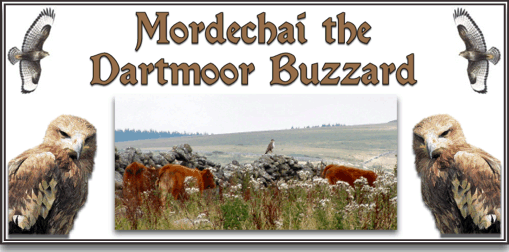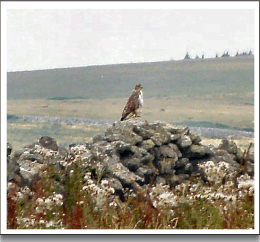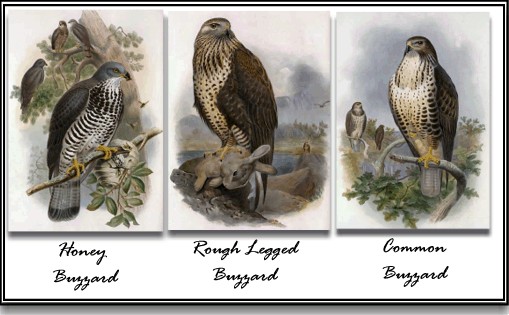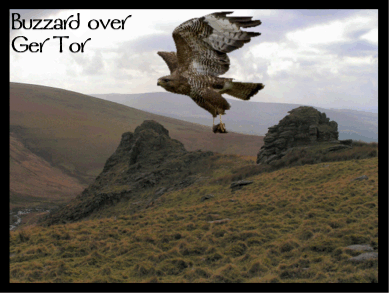
Of all the birds that grace the skies of Dartmoor, the buzzard must be the most majestic, if the National Park was to have a bird as its symbol it would surely be the buzzard. There is nothing better than to walk up onto the moor early on a summer’s morning and hear the ‘screeling’ of a buzzard as it wheels up into the sky. Equally there is nothing more evocative than on a winter’s day to see ‘Old Mordechai’ haughtily sat on a post surveying the frost bitten wastes and commons. It has become very apparent over the last twenty years or so how well established the buzzard has become, not only on Dartmoor but in the whole of Devon. In some cases living amazingly close to humans on the edges of the villages and towns of Dartmoor, so much so that if one is seen lazily floating over a town it hardly draws comment. For some reason the name of ‘Mordechai’ is one that for me is associated with the bird, I think many years ago the naturalist Simon King made a film about a Dartmoor buzzard called Mordechai? Regardless, whenever I see one it will always be, “mornin’ old Mordechai.” What irks me about the buzzard is that every time I spot one and manage to get close it flies off just as the camera is clicked. The picture below is about as close as I have ever managed to get, it was taken just above Hexworthy. But does the photo not portray the proud, haughty stance of the bird as it surveys its moorland realm?

I recall a while ago, going up towards Lud Gate just as the sun was thinking about poking its head into the dawn. The sky was fresh and clear and as I passed a small wood there was a ‘carousel’ of 14 buzzards, all at different altitudes and all riding the morning therms high into the sky. What really topped this spectacle off was that they were all calling to each other with what seemed to be joyful ‘screels’.
There are in fact three species that have frequented the moor, the Common, Rough Legged, and Common buzzards. The rarest of the three is the Honey Buzzard (Pernis apivorus) and from 1848 to 1999 there have been only 10 reported sightings of the bird, all of which have been on the southern moor. The majority of the sightings have been seen between April and September with most appearing in August. It is regarded as a very rare passage migrant.

The Rough Legged buzzard (Buteo lagopus) is another rare moorland visitor and can be regarded as a very rare winter visitor and passage migrant. There are reports of one being shot in 1877 at Ditsworthy Warren, presumably to protect the rabbits. Another was trapped near Lustleigh in 1883 and two others were rumoured to be ‘taken’ on Dartmoor in the mid 1800’s. All of the noted reports can be assumed as accurate as the bird’s carcass would have confirmed its classification as opposed to a vague sighting. Between 1970 and 1995 there were only 5 records of sightings that the Devon Bird Watching and Preservation Society will accept. These were at Amicombe Hill, Soussons, Princetown, Dartmeet, and Dendles Wood.
The Common buzzard (Buteo buteo) numbers of today certainly do not reflect those of the 1800’s, the population was a lot lower due to persecution by game keepers, warreners, and farmers. However, with the onset of the First World War the numbers started to increase, possibly due to the fact that many of those who would normally be shooting the birds were called up to shoot Germans instead. By 1911 it was reported that 7 pairs were nesting at Steps Bridge on the river Teign. The next 40 years saw a steady increase in buzzard numbers but this trend was soon reversed again with a dramatic national decline due to the myxomatosis outbreak of 1954 which effectively decimated the rabbit population and therefore the buzzards primary source of prey. It appears that the Dartmoor population did not suffer as bad as the rest of Devon and their numbers stabilised again in 1960 with reports of 10/15 pairs. The severe winter of 1964 took its toll on the birds and their numbers dropped to 8 breeding pairs. Since then buzzard numbers have increased and in 2000 it was estimated that there were 351 pairs +/-76 which is a dramatic upsurge.
Over the past few years there have been sightings of massive gatherings or a ‘wake’ of buzzards, in 1991 over the period from the 13th – 20th of September a gathering of 44 birds was reported. It is thought that the occurrence of a huge number of Crane Flies was the cause as the birds collected to feed off them.
In 1957 a notable buzzard appeared at Biggadon Farm near Buckfastleigh, it was a pure white plumed bird and which soon became a local legend until it died 16 years later in 1973.

The buzzard tends to nest in the woods and plantations of the moor but it has been known for them to build a nest on the ledges of the higher tors. Their main food source is small mammals and birds but they will also eat the carrion of dead livestock, especially in the lambing season. There have been reports that buzzards have been spotted taking adders and other reptiles which as far as I am concerned – ‘ahead go you’. The vital statistics of the buzzard are that it is 51 – 57cm long, has a wingspan of around 113 -128cm, and weighs roughly 550 – 1,000g for a male and 700 – 1,300g for a female. They lay a clutch of anything from 2 to 4 eggs which are incubated for around 5 weeks, the young fledge the nest at around 8 weeks.
 Legendary Dartmoor The many aspects past and present of Dartmoor
Legendary Dartmoor The many aspects past and present of Dartmoor

I just saw a pair of common buzzards in the air, soaring over woodland in Old Liverton. They looked so majestic, before alighting in a tree. Beautiful markings!